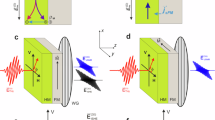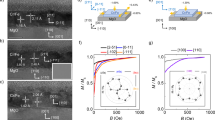Abstract
Unidirectional magnetoresistance (UMR) in a bilayer heterostructure, consisting of a spin-source material and a magnetic layer, refers to a change in the longitudinal resistance on the reversal of magnetization and originates from the interaction of non-equilibrium spin accumulation and magnetization at the interface. Since the spin polarization of an electric-field-induced non-equilibrium spin accumulation in conventional spin-source materials is restricted to be in the film plane, the ensuing UMR can only respond to the in-plane component of magnetization. However, magnets with perpendicular magnetic anisotropy are highly desired for magnetic memory and spin-logic devices, whereas the electrical read-out of perpendicular magnetic anisotropy magnets through UMR is critically missing. Here we report the discovery of an unconventional UMR in the heterostructures of a topological semimetal (WTe2) and a perpendicular magnetic anisotropy ferromagnetic insulator (Cr2Ge2Te6), which allows to electrically read the up and down magnetic states of the Cr2Ge2Te6 layer through longitudinal resistance measurements.
This is a preview of subscription content, access via your institution
Access options
Access Nature and 54 other Nature Portfolio journals
Get Nature+, our best-value online-access subscription
$32.99 / 30 days
cancel any time
Subscribe to this journal
Receive 12 print issues and online access
$259.00 per year
only $21.58 per issue
Buy this article
- Purchase on SpringerLink
- Instant access to full article PDF
Prices may be subject to local taxes which are calculated during checkout





Similar content being viewed by others
Data availability
All the data supporting the findings of this study are available in the Article and its Supplementary Information. Further information is available from the corresponding author on reasonable request.
References
Baibich, M. N. et al. Giant magnetoresistance of (001)Fe/(001)Cr magnetic superlattices. Phys. Rev. Lett. 61, 2472–2475 (1988).
Binasch, G., Grünberg, P., Saurenbach, F. & Zinn, W. Enhanced magnetoresistance in layered magnetic structures with antiferromagnetic interlayer exchange. Phys. Rev. B 39, 4828–4830 (1989).
Julliere, M. Tunneling between ferromagnetic films. Phys. Lett. A 54, 225–226 (1975).
Nakayama, H. et al. Spin Hall magnetoresistance induced by a nonequilibrium proximity effect. Phys. Rev. Lett. 110, 206601 (2013).
Nakayama, H. et al. Rashba-Edelstein magnetoresistance in metallic heterostructures. Phys. Rev. Lett. 117, 116602 (2016).
Yasuda, K. et al. Large unidirectional magnetoresistance in a magnetic topological insulator. Phys. Rev. Lett. 117, 127202 (2016).
Lu, Y. M. et al. Hybrid magnetoresistance in the proximity of a ferromagnet. Phys. Rev. B 87, 220409 (2013).
Avci, C. O. et al. Unidirectional spin Hall magnetoresistance in ferromagnet/normal metal bilayers. Nat. Phys. 11, 570–575 (2015).
Lv, Y. et al. Unidirectional spin-Hall and Rashba−Edelstein magnetoresistance in topological insulator-ferromagnet layer heterostructures. Nat. Commun. 9, 111 (2018).
Zhang, S. S. L. & Vignale, G. Theory of unidirectional spin Hall magnetoresistance in heavy-metal/ferromagnetic-metal bilayers. Phys. Rev. B 94, 140411 (2016).
Shim, S. et al. Unidirectional magnetoresistance in antiferromagnet/heavy-metal bilayers. Phys. Rev. X 12, 021069 (2022).
Duy Khang, N. H. & Hai, P. N. Giant unidirectional spin Hall magnetoresistance in topological insulator–ferromagnetic semiconductor heterostructures. J. Appl. Phys. 126, 233903 (2019).
Lv, Y. et al. Large unidirectional spin Hall and Rashba−Edelstein magnetoresistance in topological insulator/magnetic insulator heterostructures. Appl. Phys. Rev. 9, 011406 (2022).
Cheng, Y. et al. Unidirectional spin Hall magnetoresistance in antiferromagnetic heterostructures. Phys. Rev. Lett. 130, 086703 (2023).
Edelstein, V. M. Spin polarization of conduction electrons induced by electric current in two-dimensional asymmetric electron systems. Solid State Commun. 73, 233–235 (1990).
Johansson, A., Henk, J. & Mertig, I. Edelstein effect in Weyl semimetals. Phys. Rev. B 97, 085417 (2018).
Garate, I. & Franz, M. Inverse spin-galvanic effect in the interface between a topological insulator and a ferromagnet. Phys. Rev. Lett. 104, 146802 (2010).
Miron, I. M. et al. Perpendicular switching of a single ferromagnetic layer induced by in-plane current injection. Nature 476, 189–193 (2011).
Liu, L. et al. Spin-torque switching with the giant spin Hall effect of tantalum. Science 336, 555–558 (2012).
Liu, L., Lee, O. J., Gudmundsen, T. J., Ralph, D. C. & Buhrman, R. A. Current-induced switching of perpendicularly magnetized magnetic layers using spin torque from the spin Hall effect. Phys. Rev. Lett. 109, 096602 (2012).
Mellnik, A. R. et al. Spin-transfer torque generated by a topological insulator. Nature 511, 449–451 (2014).
Sinova, J., Valenzuela, S. O., Wunderlich, J., Back, C. H. & Jungwirth, T. Spin Hall effects. Rev. Mod. Phys. 87, 1213–1260 (2015).
Shao, Q. et al. Roadmap of spin–orbit torques. IEEE Trans. Magn. 57, 800439 (2021).
Avci, C. O., Lambert, C.-H., Sala, G. & Gambardella, P. A two-terminal spin valve device controlled by spin–orbit torques with enhanced giant magnetoresistance. Appl. Phys. Lett. 119, 032406 (2021).
Damerio, S. et al. Magnetoresistive detection of perpendicular switching in a magnetic insulator. Commun. Phys. 7, 114 (2024).
Sato, N., Xue, F., White, R. M., Bi, C. & Wang, S. X. Two-terminal spin–orbit torque magnetoresistive random access memory. Nat. Electron. 1, 508–511 (2018).
Wang, M. et al. Field-free switching of a perpendicular magnetic tunnel junction through the interplay of spin–orbit and spin-transfer torques. Nat. Electron. 1, 582–588 (2018).
Zhao, Y. et al. Anisotropic magnetotransport and exotic longitudinal linear magnetoresistance in WTe2 crystals. Phys. Rev. B 92, 041104 (2015).
Gong, C. et al. Discovery of intrinsic ferromagnetism in two-dimensional van der Waals crystals. Nature 546, 265–269 (2017).
Wang, Z. et al. Electric-field control of magnetism in a few-layered van der Waals ferromagnetic semiconductor. Nat. Nanotechnol. 13, 554–559 (2018).
Soluyanov, A. A. et al. Type-II Weyl semimetals. Nature 527, 495–498 (2015).
MacNeill, D. et al. Control of spin–orbit torques through crystal symmetry in WTe2/ferromagnet bilayers. Nat. Phys. 13, 300–305 (2017).
Kao, I. H. et al. Deterministic switching of a perpendicularly polarized magnet using unconventional spin–orbit torques in WTe2. Nat. Mater. 21, 1029–1034 (2022).
Fei, Z. et al. Ferroelectric switching of a two-dimensional metal. Nature 560, 336–339 (2018).
de la Barrera, S. C. et al. Direct measurement of ferroelectric polarization in a tunable semimetal. Nat. Commun. 12, 5298 (2021).
Mogi, M. et al. Large anomalous Hall effect in topological insulators with proximitized ferromagnetic insulators. Phys. Rev. Lett. 123, 016804 (2019).
Gupta, V. et al. Gate-tunable anomalous Hall effect in a 3D topological insulator/2D magnet van der Waals heterostructure. Nano Lett. 22, 7166–7172 (2022).
Li, J. et al. Proximity-magnetized quantum spin Hall insulator: monolayer 1 T′ WTe2/Cr2Ge2Te6. Nat. Commun. 13, 5134 (2022).
Bauer, G. E. W., Saitoh, E. & van Wees, B. J. Spin caloritronics. Nat. Mater. 11, 391–399 (2012).
Avci, C. O. et al. Interplay of spin-orbit torque and thermoelectric effects in ferromagnet/normal-metal bilayers. Phys. Rev. B 90, 224427 (2014).
Xue, F., Rohmann, C., Li, J., Amin, V. & Haney, P. Unconventional spin-orbit torque in transition metal dichalcogenide–ferromagnet bilayers from first-principles calculations. Phys. Rev. B 102, 014401 (2020).
Garcia, J. H. et al. Canted persistent spin texture and quantum spin Hall effect in WTe2. Phys. Rev. Lett. 125, 256603 (2020).
Zhao, W. et al. Magnetic proximity and nonreciprocal current switching in a monolayer WTe2 helical edge. Nat. Mater. 19, 503–507 (2020).
Snoeck, E. et al. Experimental evidence of the spin dependence of electron reflections in magnetic CoFeO4/Au/Fe3O4 trilayers. Phys. Rev. B 73, 104434 (2006).
Liu, G. et al. Magnonic unidirectional spin Hall magnetoresistance in a heavy-metal–ferromagnetic-insulator bilayer. Phys. Rev. Lett. 127, 207206 (2021).
Liu, Y. et al. Field-free switching of perpendicular magnetization at room temperature using out-of-plane spins from TaIrTe4. Nat. Electron. 6, 732–738 (2023).
Kondou, K. et al. Giant field-like torque by the out-of-plane magnetic spin Hall effect in a topological antiferromagnet. Nat. Commun. 12, 6491 (2021).
Hazra, B. K. et al. Generation of out-of-plane polarized spin current by spin swapping. Nat. Commun. 14, 4549 (2023).
Liu, S. et al. Single crystal growth of millimeter-sized monoisotopic hexagonal boron nitride. Chem. Mater. 30, 6222–6225 (2018).
Song, Q. et al. The polarization-dependent anisotropic Raman response of few-layer and bulk WTe2 under different excitation wavelengths. RSC Adv. 6, 103830–103837 (2016).
He, P. et al. Bilinear magnetoelectric resistance as a probe of three-dimensional spin texture in topological surface states. Nat. Phys. 14, 495–499 (2018).
Zarezad, A. N., Barnaś, J., Qaiumzadeh, A. & Dyrdał, A. Bilinear planar Hall effect in topological insulators due to spin-momentum locking inhomogeneity. Phys. Status Solidi RRL 18, 2200483 (2024).
Acknowledgements
S.S. acknowledges financial support from the National Science Foundation (NSF) through grant no. ECCS-2208057; US Office of Naval Research under award no. N00014-23-1-2751; and the Center for Emergent Materials at The Ohio State University, an NSF MRSEC, through award no. DMR-2011876. S.S. also acknowledges financial support from the NSF CAREER Award through grant no. ECCS-2339723. J.K. acknowledges financial support from the US Office of Naval Research under award no. N00014-23-1-2751; the Center for Emergent Materials at The Ohio State University, an NSF MRSEC, through award no. DMR-2011876; and the US Department of Energy, Office of Science, Office of Basic Sciences, through award no. DE-SC0020323. J.K. also acknowledges financial support from the NSF CAREER Award under grant no. DMR-2339309. J.T. and R.C. are supported by the Air Force Office of Scientific Research under grant FA9550-19-1-0307. J.Y. acknowledges support from the US Department of Energy, Office of Science, Basic Energy Sciences, Materials Sciences and Engineering Division. D.G.M. acknowledges support from the Gordon and Betty Moore Foundation’s EPiQS Initiative through grant no. GBMF9069. J.H. acknowledges financial support from the Center for Emergent Materials, an NSF MRSEC, through award no. DMR-2011876. Electron microscopy was performed at the Center for Electron Microscopy and Analysis at The Ohio State University. J.H.E. acknowledges support for the hBN crystal growth from the US Office of Naval Research under award no. N00014-22-1-2582. K.W. and T.T. acknowledge support from the JSPS KAKENHI (grant nos. 21H05233 and 23H02052) and World Premier International Research Center Initiative (WPI), MEXT, Japan. We also thank Ryan Muzzio for his help to prepare the schematic of the WTe2 crystal structure shown in Fig. 1.
Author information
Authors and Affiliations
Contributions
S.S. and J.K. supervised the research. I.-H.K. prepared the devices and performed the experiments with assistance from S.Y. J.T. and R.C. performed the theoretical and numerical calculations. G.C.O., M.Z. and J.H. performed the STEM measurements. R.R. carried out the polarized Raman measurements. J.Y. and D.G.M. provided the bulk crystals of WTe2. J.L., J.H.E., K.W. and T.T. provided the bulk hBN crystals. All authors contributed to writing the manuscript.
Corresponding author
Ethics declarations
Competing interests
The authors declare no competing interests.
Peer review
Peer review information
Nature Materials thanks Can Onur Avci and the other, anonymous, reviewer(s) for their contribution to the peer review of this work.
Additional information
Publisher’s note Springer Nature remains neutral with regard to jurisdictional claims in published maps and institutional affiliations.
Supplementary information
Supplementary Information
Supplementary Notes 1–12, Figs. 1–23 and Tables 1 and 2.
Rights and permissions
Springer Nature or its licensor (e.g. a society or other partner) holds exclusive rights to this article under a publishing agreement with the author(s) or other rightsholder(s); author self-archiving of the accepted manuscript version of this article is solely governed by the terms of such publishing agreement and applicable law.
About this article
Cite this article
Kao, IH., Tang, J., Ortiz, G.C. et al. Unconventional unidirectional magnetoresistance in heterostructures of a topological semimetal and a ferromagnet. Nat. Mater. 24, 1049–1057 (2025). https://doi.org/10.1038/s41563-025-02175-0
Received:
Accepted:
Published:
Issue date:
DOI: https://doi.org/10.1038/s41563-025-02175-0
This article is cited by
-
Unidirectional magnetoresistance goes perpendicular
Nature Materials (2025)



